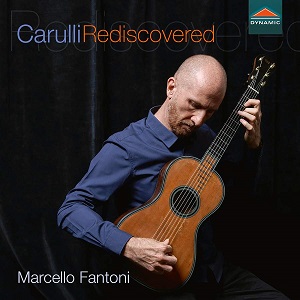
Ferdinando Carulli (1770-1841)
Rediscovered
Trois divertissemensts à l’Espagnole*
La Clochette, Fantaisie pour la guitar sur un thème de Paganini, Op. 325
Airs Nationaux de tous les Peuples d’Europe, Op 73*
Solo avec Variations sur l’air de Le Molinara, Op. 107
La Folle, Romance d’Albert Grisar, arrangée en Fantaisie pour la guitare, Op 363*
Trois Valses pour la guitare, Op. 9*
Marcello Fantoni (guitar)
rec. 2021, Chiesa di San Bartolomeo, Nomaglio (Turin), Italy
* First Recording
DYNAMIC CDS7956 [77]
Andrès Segovia claimed that he had to rescue the guitar twice: once from the hands of the noisy flamencos, and again from its poor repertory. Ironically, Segovia commenced his career as a flamenco guitarist. He later praised ‘the noble style’ of flamenco guitarist Paco Lucina, and transcribed some of his falsetas.
While he gave reserved accolades to Fernando Sor, he spoke of ‘little’ contribution by Mauro Giuliani and Ferdinando Carulli. The remainder he grouped together as ‘very poor without the proper training inmusic’: this gave to the guitar ‘a fervent and devoted incompetence’ Taking Segovia literally, he obviously included Aguado and Tarrega, despite extensively recording their music.
The guitar, in the present iteration by which we have come to recognise it, has a relatively short history- a couple of hundred years. By necessity most of the early virtuosi wrote their own music. While there are masterpieces among this early music, the volume of composition far exceeds the quality. It is also highly probable that Segovia did not have access to the original manuscripts by these early key guitar composers. There are indications that his arrangements of the famous Sor 20 Studies were based on the manuscripts of Napoleon Coste, rather than that of his teacher, Sor.
In the annals of the guitar the name Ferdinando Carulli is eminent, due, in the main, to his rather mediocre tutor for the instrument. This recording centres exclusively on the solo compositions of Carulli and considers his music, per se, as the key reason why he deserves a more prominent position in the pantheon of those who composed for the guitar.
Carulli was born in Naples in 1770 to an affluent upper-class family. His first instrument was cello, but when he was 20, he discovered the guitar and devoted his life to the study, advancement and composition for the instrument. A gifted autodidact, his popular concerts in Naples led him to begin touring Europe. After his marriage circa 1801, and the advent of a son, he started to compose in Milan. Subsequent to a most successful Paris tour, he finally moved there, becoming a highly successful teacher and remaining until his death in 1841.
Carulli was a prolific composer and, depending on which source is referenced, his entire opus exceeded 400 works. These include: solo guitar, duets with guitar, violin, piano, and flute; guitar and orchestra, guitar, flute and orchestra; chamber works for guitar and two other instrments Not extensively recorded, much of his opera did not become more generally available until the middle and latter part of the 20th century. However, famous performers such as Pepe Romero, John Williams, Julian Bream have recorded music by him.
For this recording Marcello Fantoni selected essentially the less known and unfamiliar solo guitar compositions from the pen of Carulli. The longest is Airs Nationaux de tous les Peuples d’ Europe, opus 73 ]27:54], within which there are six sections. Of the remaining five items, the shortest plays for 5:52. Given the frequency with which Carulli has been recorded, selecting unfamiliar repertory would not be particularly challenging, as is well evidenced by four of the programme items here being world premier recordings.
Marcello Fantoni studied at the Conservatory ‘G Verdi’ of Milan from which he graduated in 1996 with distinction and cum laude with guitar in the performing examination. He also studied composition with Danilo Lorenzini and Davide Anzaghi at the same institute. In 1996 he was admitted to the Mozarteum in Salzburg under the tutelage of Eliot Fisk. In 2002 he obtained a Master of Science Degree in Secondary Musical Education at the Faculty of Musicology of Cremona. In addition to a Masters Degree (2007) in Discipline Musical Chitarre at the Conservatory ‘L Cherubini’ of Florence, he also studied with Paolo Paolini, Eduardo Fernandez, Timo Koronen, Leo Brower, Pavel Steidel and Oscar Ghiglia. He has an extensive discography of music for the classical guitar.
Like all guitar composers of the era, not everything Carulli wrote was a repertory treasure. It is however obvious that the recorded items here were selected on the basis of above average merit, and as such, provide an enjoyable and enlightening listening experience. Whether it is the actual sound of this particular guitar, the programme items selected, or simply the overall performance, one must give full credit to Fantoni for a first- class recording. He is a fine musician and an excellent guitarist.
Carulli also experimented with instrument making toward the end of his life, and collaborated with Parisian luthier René Lacote. The guitar used in this recording was made by Lacote in 1820. It is constructed of the highest quality materials by the most important and innovative guitar maker of
the 19th century. Unlike its stringed relatives, the guitar has undergone very significant structural changes since the time of Lacote. Today’s guitar is larger, tonally better balanced, and can produce more volume with better tonal qualities than its historical relative. That said, the instrument played here by Fantoni has a most pleasing sound, and complements the period of the composer. A case for HIP could almost be mounted.
After auditioning this recording, one is left with the impression that, because the music of Carulli has been relatively unknown, it is potentially misunderstood and undervalued. The excellent performance by Marcello Fantoni augments that impression.
Zane Turner
Help us financially by purchasing from





















